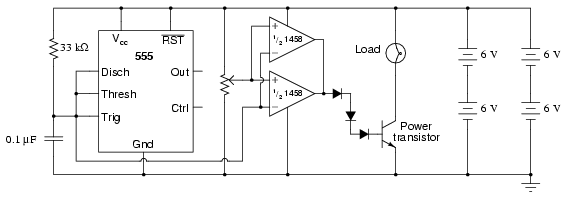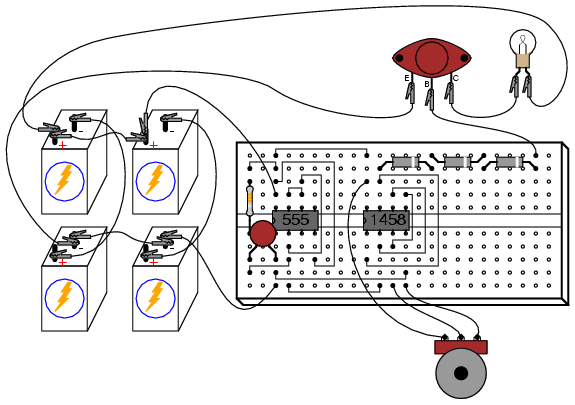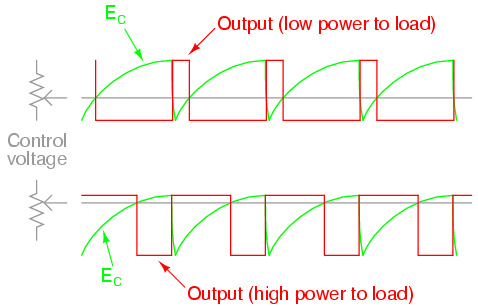PWM power controller
PARTS AND MATERIALS
-
Four 6 volt batteries
-
One capacitor, 100 �F electrolytic, 35
WVDC (Radio Shack catalog # 272-1028 or equivalent)
-
One capacitor, 0.1 �F, non-polarized
(Radio Shack catalog # 272-135)
-
One 555 timer IC (Radio Shack catalog #
276-1723)
-
Dual operational amplifier, model 1458
recommended (Radio Shack catalog # 276-038)
-
One NPN power transistor -- (Radio Shack
catalog # 276-2041 or equivalent)
-
Three 1N4001 rectifying diodes (Radio
Shack catalog # 276-1101)
-
One 10 kΩ potentiometer, linear taper
(Radio Shack catalog # 271-1715)
-
One 33 kΩ resistor
-
12 volt automotive tail-light lamp
-
Audio detector with headphones
CROSS-REFERENCES
Lessons In Electric Circuits, Volume
3, chapter 8: "Operational Amplifiers"
Lessons In Electric Circuits, Volume
2, chapter 7: "Mixed-Frequency AC Signals"
LEARNING OBJECTIVES
-
How to use the 555 timer as an astable
multivibrator
-
How to use an op-amp as a comparator
-
How to use diodes to drop unwanted DC
voltage
-
How to control power to a load by
pulse-width modulation
SCHEMATIC DIAGRAM

ILLUSTRATION

INSTRUCTIONS
This circuit uses a 555 timer to generate a
sawtooth voltage waveform across a capacitor, then compares
that signal against a steady voltage provided by a
potentiometer, using an op-amp as a comparator. The
comparison of these two voltage signals produces a
square-wave output from the op-amp, varying in duty cycle
according to the potentiometer's position. This variable
duty cycle signal then drives the base of a power
transistor, switching current and and off through the load.
The 555's oscillation frequency is much higher than the lamp
filament's ability to thermally cycle (heat and cool), so
any variation in duty cycle, or pulse width, has the
effect of controlling the total power dissipated by the load
over time.

Controlling electrical power through a load
by means of quickly switching it on and off, and varying the
"on" time, is known as pulse-width modulation, or
PWM. It is a very efficient means of controlling
electrical power because the controlling element (the power
transistor) dissipates comparatively little power in
switching on and off, especially if compared to the wasted
power dissipated of a rheostat in a similar situation. When
the transistor is in cutoff, its power dissipation is zero
because there is no current through it. When the transistor
is saturated, its dissipation is very low because there is
little voltage dropped between collector and emitter while
it is conducting current.
PWM is a concept easier understood through
experimentation than reading. It would be nice to view the
capacitor voltage, potentiometer voltage, and op-amp output
waveforms all on one (triple-trace) oscilloscope to see how
they relate to one another, and to the load power. However,
most of us have no access to a triple-trace oscilloscope,
much less any oscilloscope at all, so an alternative method
is to slow the 555 oscillator down enough that the three
voltages may be compared with a simple DC voltmeter. Replace
the 0.1 �F capacitor with one that is 100 �F or larger. This
will slow the oscillation frequency down by a factor of at
least a thousand, enabling you to measure the capacitor
voltage slowly rise over time, and the op-amp output
transition from "high" to "low" when the capacitor voltage
becomes greater than the potentiometer voltage. With such a
slow oscillation frequency, the load power will not be
proportioned as before. Rather, the lamp will turn on and
off at regular intervals. Feel free to experiment with other
capacitor or resistor values to speed up the oscillations
enough so the lamp never fully turns on or off, but is
"throttled" by quick on-and-off pulsing of the transistor.
When you examine the schematic, you will
notice two operational amplifiers connected in
parallel. This is done to provide maximum current output to
the base terminal of the power transistor. A single op-amp
(one-half of a 1458 IC) may not be able to provide
sufficient output current to drive the transistor into
saturation, so two op-amps are used in tandem. This should
only be done if the op-amps in question are
overload-protected, which the 1458 series of op-amps are.
Otherwise, it is possible (though unlikely) that one op-amp
could turn on before the other, and damage result from the
two outputs short-circuiting each other (one driving "high"
and the other driving "low" simultaneously). The inherent
short-circuit protection offered by the 1458 allows for
direct driving of the power transistor base without any need
for a current-limiting resistor.
The three diodes in series connecting the
op-amps' outputs to the transistor's base are there to drop
voltage and ensure the transistor falls into cutoff when the
op-amp outputs go "low." Because the 1458 op-amp cannot
swing its output voltage all the way down to ground
potential, but only to within about 2 volts of ground, a
direct connection from the op-amp to the transistor would
mean the transistor would never fully turn off. Adding three
silicon diodes in series drops approximately 2.1 volts (0.7
volts times 3) to ensure there is minimal voltage at the
transistor's base when the op-amp outputs go "low."
It is interesting to listen to the op-amp
output signal through an audio detector as the potentiometer
is adjusted through its full range of motion. Adjusting the
potentiometer has no effect on signal frequency, but it
greatly affects duty cycle. Note the difference in tone
quality, or timbre, as the potentiometer varies the
duty cycle from 0% to 50% to 100%. Varying the duty cycle
has the effect of changing the harmonic content of the
waveform, which makes the tone sound different.
You might notice a particular uniqueness to
the sound heard through the detector headphones when the
potentiometer is in center position (50% duty cycle -- 50%
load power), versus a kind of similarity in sound just above
or below 50% duty cycle. This is due to the absence or
presence of even-numbered harmonics. Any waveform that is
symmetrical above and below its centerline, such as a square
wave with a 50% duty cycle, contains no even-numbered
harmonics, only odd-numbered. If the duty cycle is below or
above 50%, the waveform will not exhibit this
symmetry, and there will be even-numbered harmonics. The
presence of these even-numbered harmonic frequencies can be
detected by the human ear, as some of them correspond to
octaves of the fundamental frequency and thus "fit" more
naturally into the tone scheme. |